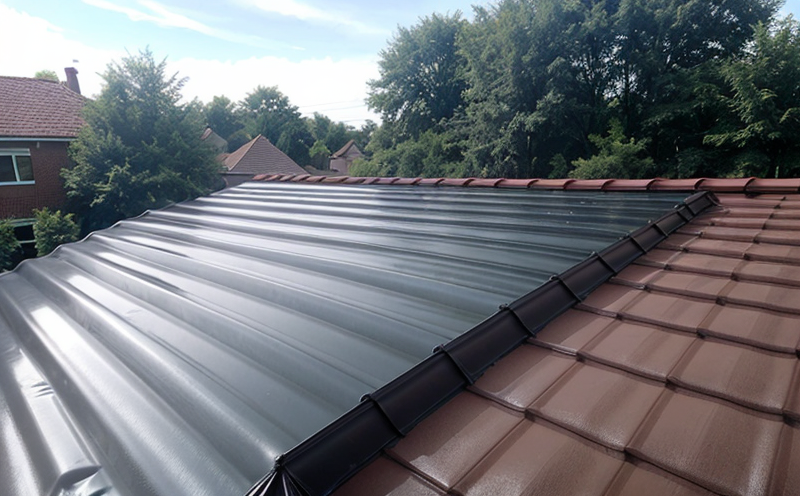ASTM D5149 Roofing Membrane Water Resistance Testing
The ASTM D5149 standard test method is specifically designed to evaluate the water resistance properties of roofing membranes. This comprehensive testing ensures that roofs can effectively resist water penetration, which is critical for durability and longevity in various building and infrastructure applications.
Roofing membranes play a vital role in protecting buildings from environmental elements such as rain, snow, and wind. The integrity of these materials directly impacts the overall performance and lifespan of structures. ASTM D5149 provides a standardized approach to determining how well roofing materials can withstand water intrusion under controlled conditions.
The test involves placing a specimen of the roofing membrane in contact with water for a specified duration while maintaining constant temperature and relative humidity levels. The specimen is then observed for any signs of leakage or wetting. This process helps identify potential vulnerabilities within the material, allowing manufacturers to improve their products before they are installed.
Understanding the importance of this test requires knowledge about common roofing materials used in construction projects. These can range from bituminous felt and modified bitumen sheets to single-ply membranes like polyvinyl chloride (PVC) or thermoplastic olefin (TPO). Each type has its unique properties, making it essential for testing them according to industry standards.
Proper specimen preparation is crucial before conducting ASTM D5149 tests. Specimens should be cut into standard sizes and shapes as per the test requirements. It's important to note that improper cutting can lead to inaccurate results since variations in sample geometry could affect water flow dynamics during testing.
The equipment used for this type of testing includes specialized chambers capable of maintaining precise temperature and humidity conditions throughout the duration of the experiment. Additionally, video cameras or other monitoring devices are often employed to capture any visual evidence of moisture penetration without disturbing the specimen.
After completing the ASTM D5149 test according to specified parameters, qualified personnel analyze the results closely. They look for specific indicators such as leakage rates, contact angles between water and the membrane surface, or even direct observation of wetting patterns. Based on these observations, they determine whether the roofing material meets acceptable performance criteria outlined by the standard.
Understanding why ASTM D5149 is relevant extends beyond just compliance; it also serves practical purposes in quality assurance processes. By ensuring that roofs are properly protected against water ingress, building owners can extend the life of their structures while reducing maintenance costs associated with leaks or damage caused by excessive exposure to moisture.
For those involved in construction projects, understanding ASTM D5149 not only aids in selecting appropriate roofing materials but also informs decisions regarding installation techniques and ongoing inspections. Proper adherence to this testing protocol helps maintain high standards across the industry, ultimately contributing to safer, more efficient buildings that stand up well over time.
Eurolab Advantages
- Comprehensive Expertise: Our team of experts has extensive experience in conducting various ASTM tests including D5149, ensuring accurate and reliable results.
- State-of-the-Art Facilities: Equipped with advanced equipment that meets stringent quality control standards, we provide precise testing environments for all your needs.
- Comprehensive Reporting: Detailed reports are provided alongside every test result, offering insights into performance metrics and areas for improvement.
- Fast Turnaround Times: We understand the importance of timely results. Our efficient processes ensure quick turnaround times without compromising on accuracy or thoroughness.
Choose Eurolab for your ASTM D5149 Roofing Membrane Water Resistance Testing needs, where precision and reliability are paramount.
Environmental and Sustainability Contributions
- Eco-Friendly Materials: By ensuring that roofing membranes meet strict water resistance standards like ASTM D5149, we promote the use of sustainable materials which contribute positively to environmental protection.
- Reduced Maintenance Costs: Properly tested and installed roofs are less likely to suffer from leaks or other issues, leading to lower long-term maintenance expenses for building owners.
The ASTM D5149 test method plays a crucial role in promoting sustainable practices within the construction industry. Through rigorous testing procedures, it helps identify robust roofing solutions that contribute significantly towards reducing waste and improving overall energy efficiency of buildings.
Use Cases and Application Examples
| Application Scenario | Description |
|---|---|
| Data Centers | Ensuring that roof membranes are watertight is crucial for protecting sensitive electronic equipment housed in data centers. |
| Hospitals | Waterproofing roofs helps prevent contamination risks and maintains hygienic conditions within hospital premises. |
| Residential Buildings | A well-tested roof membrane can enhance the comfort of residents by providing better insulation against cold weather while keeping interiors dry during rainy seasons. |
| Commercial Properties | In commercial spaces, proper roofing integrity ensures occupant safety and protects valuable assets from water damage. |
- Data Centers: High-tech environments require constant protection against external elements. Waterproofing roofs helps maintain operational continuity by safeguarding critical infrastructure.
- Hospitals: In healthcare settings, cleanliness and safety are paramount. A robust roof membrane minimizes risks associated with water intrusion into sensitive areas of the facility.
These examples highlight just a few scenarios where ASTM D5149 testing is vital for maintaining high standards in construction practices. Whether it's protecting valuable assets or ensuring occupant safety, this test method plays an indispensable role across various sectors.





